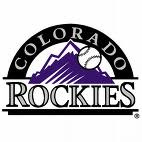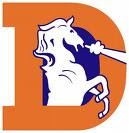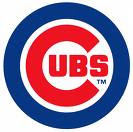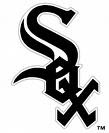In the history of bad Colorado sports contracts, the Colorado Rockies had a contribution or two of their own. If there were any one pair of signings that Dealin’ Dan takes the most heat for in his legacy as Rox GM…it would have to be the dual signing of Mike Hampton and Denny Neagle and their HUGE contracts. Those two player contracts mark the “bad legacy” for Dealin’ Dan. The signing of these two players has also left a bad taste in the mouth of many Rox fans.
In December of 2000, Dealin’ Dan opened the Rox checkbook and brought in two free agent pitchers from other clubs for lucrative amounts of cash. Neagle was the first to ink a deal with the Rockies on December 4, 2000. Neagle was lured into hitter’s friendly Coors Field for a whopping $51 million deal over 5 years. Even at the time many fans and experts scratched their heads with the signing.
Neagle was a coveted left-handed pitcher, but he wasn’t the typical pitcher envisioned to have success at Coors Field. Neagle did not have over-powering stuff, and was a fly ball pitcher in a park that allowed the ball to carry further than any other parks.
As a fan, I was left with the weird expression of “huh?”on my face. I didn’t agree with Dealin’ Dan’s signing, but I was glad that he was being aggressive in making the team competitive. I personally thought Neagle was washed up. Oh well.
I knew that the Rox organization had money, and now someone was willing to spend some to upgrade the team on the field and hopefully make it competitive for the next couple years. I didn’t agree with the signing because we paid wayyy too much, but I was happy to see a positive direction from our new GM.
While fans around the front range of the Rockies were digesting the signing of Neagle, Dealin’ Dan struck another expensive deal with another left-handed pitcher. Hampton signed with the Rockies on December 12, 2000 for a deal reportedly worth $121million over 8 years. It was the largest contract to date for a baseball player.
I thought that $51 million deal was tough to swallow, but $121 million. Holy Crap. This deal better be worth it. Hampton was a successful pitcher coming off a couple of good years and a CY Young Award. He was another one of those “groundball pitchers” with a good hook (curveball…or hanging curveball in Coors Field history) that the Rockies have tried to make work in the past few years.
As I said before, I was glad to see the opening of the checkbook, but I even knew that Hampton’s contract was too steep for its own good. I admit I was really skeptical about Hampton ability to pitch in Coors Field. My theory at the time was to invest in:
A.) A lot of hitters and just pound the crap out of the ball and win 15-8
or
B.) Invest in a pitcher who could really bring the “heat”. None of this breaking ball B.S. Strike em’ out or hit em’ out!
That’s my philosophy when it comes to succeeding in Coors Field. But then again, I'm not a GM of a baseball team. Too bad because those would be some fun games to watch!
At the time I had a bad feeling about the two deals. I would have rather spent money on sluggers than those two high profile (and high priced) pitchers. As I said, I love to see my team make a play at winning, but…really…is $121 million ($172 million) worth it? Unfortunately Rockie fans and I was about to find out.
Hampton’s Playing Days
Let’s start on a positive note, Hampton did win two National League Awards in the two seasons at Coors. Unfortunately they were awards for
 hitting and not pitching. Yes, the Rox brought in Hampton to fire strikes and win games as a southpaw, but the only real success Hampton showed the Rox was his ability to hit the ball.
hitting and not pitching. Yes, the Rox brought in Hampton to fire strikes and win games as a southpaw, but the only real success Hampton showed the Rox was his ability to hit the ball.Hampton won two N.L. Silver Slugger Awards (at the pitcher’s spot) by demonstrating that he could hit the ball better than any other pitcher. Hampton ended up hitting .315 with 10 HR’s and 21 RBI’s in his two years with the Rox. Don’t get me wrong, it’s truly a great honor for a pitcher to win that award. I would have rather had Hampton have more success throwing the ball than hitting it.
For every HR he would give up, Hampton would hit one himself. The only problem was that he gave them up quicker than he could hit them (31 vs. 7). Hampton ended up hitting 7 HR’s in 2000 and 3 HR’s in 2001. That’s pretty damn good for a pitcher. In the modern day era of baseball, he holds the record for HR’s by a pitcher in a year with 7.
The only problem is that the Rox weren’t paying him $121 million to hit an average of five HR’s a year. Deep down it is a little funny. My philosophy was to pay money to hitters to out-slug the competition. The Rox ended up paying for a slugger…to hit every five days…maybe once or twice in a game before getting pulled for a reliever. At least on some level I was happy about the deal.
The first year with Hampton as a starter wasn’t so bad. It actually looked like the deal would work out. Hampton became the Rox first starting pitcher to make the All-Star game as he cruised into the break with a 9-5 record. Of course his bat was just as deadly at the time also.
Hampton's performance on the field had made Dealin' Dan look really good. Hampton had already had three games where he pitched into either the 8th or 9th and had not given up a run, including a masterful Opening Day shutout of the St.Louis Cardinals (8-0 win).
Then for some reason the wheels began to roll off the wagon. Maybe the reason had something to do with commitment. Maybe Hampton felt betrayed by the Rox organization as Dealin’ Dan went on a tirade and started trading players on the team in moves that made the players feel astonished and shocked.
Dealin’ Dan started with trade frenzy on June 24, 2001 by trading their starting catcher, Brent
 Mayne (Pictured Right) to Kansas City for prospects P Mac Suzuki and C Sal Fasano. I remember Hampton being upset with this trade because the second half of the pitcher-catcher battery had just been dealt away for nothing in mid-season the Rox were 37-38 a game below .500…so anything was still possible.
Mayne (Pictured Right) to Kansas City for prospects P Mac Suzuki and C Sal Fasano. I remember Hampton being upset with this trade because the second half of the pitcher-catcher battery had just been dealt away for nothing in mid-season the Rox were 37-38 a game below .500…so anything was still possible.Other trades to go down the pipeline within the next month involved the departures of 2B Todd Walker, SS Neifi Perez, and SP Pedro Astacio for numerous prospects (Click here to read the Trade section of Dealin’ Dan’s legacy). Within a month the Rox lost their starting C, 2B, SS and a pitcher out of the rotation. The Rox would go 9-26 over that span leading up to the July 31 deadline. Did Hampton have some beef about management’s future direction of the club?
Probably.
A person can only speculate over someone else’s feeling about the matter. I can see where Hampton felt betrayed a little bit in this matter. He was brought in as a free agent for a lot of cash, but with the promise of winning by the Rox management. At the time the writing on the wall said that the Rox were going to spend money and compete. It looked good and sounded good, but by the half way point of the season, things seemed a little different.
Mayne was a very quiet and class act type of guy, so there wasn’t any real need to dump him. He wasn’t a super stud catcher, but Hampton and Mayne seemed to have developed a relationship. Then out of the blue he was gone to KC. The team was caught off guard by the trade just like the fans were. I think this is the starting point of Hampton’s downward spiral as a Rockie.
Hampton ended up dropping 4 straight decisions after the Mayne trade. You decide whether or not that trade effected him. Hampton was 9-3 with him, and 5-10 with out him. Hampton also had given up 31 HR's on the year, 24 of them came after the Mayne trade.
After being selected as an All-Star, Hampton’s performance slipped and he ended the year with a 14-13 record…which also means that he went 5-8 after the break. This below expectation performance continued into the 2002 season, his second year as a Rockie.
Hampton did not come out of the gates as great as he did the year before, and struggled many times throughout the season. Hampton started the year 0-3 and never came close to becoming a .500 pitcher. The looming shadow of high expectations from his lucrative contract hovered over him as the relationship with the team, fans and media quickly went down the tubes.
Hampton’s failures on the mound and huge contract had sparked great criticism by anyone giving an opinion on the matter. As a fan watching the game I could see that the pressure and failure had just “broke” Hampton to the point of no return. For lack of a better term…he just seemed to have given up. It was time for him and the Rox to part ways.
By mid summer of 2001, it was crystal clear that the Hampton Era was over. The Rox were in another rebuilding stage (for the umpteenth time) and they were well out of the playoff race. Hampton was nothing “stellar” himself and looked like he wanted out the door. It was just a matter of time before the two sides parted ways. During the two years of his tenure with the Rox, Hampton racked up these stats:

If getting royally screwed on Hampton’s contract wasn’t a bad enough, Dealin’ Dan went back for seconds by trying to trade him. Desperate to trade a huge mistake, Dealin’ Dan made probably an even bigger one trying to get rid of Hampton.
Twenty three months after making Hampton the highest paid pitcher in baseball history, Dealin’ Dan shipped Hampton along with CF Juan Pierre (3 yr/$6.6 million contract) and cash to the Florida Marlins for OF Preston Wilson, C Charles Johnson, P Vic Darensburg and 2B/OF Pablo Ozuna on November 16, 2002. Florida would turn around and deal him to the Braves for crap…a.k.a. salary dump.
On paper…four players for two doesn’t look so bad, but in reality it really sucked for the Rox. The details of the trade were just as devastating as signing Hampton in the first place. What the average fan probably didn’t know about the trade was how lopsided the financial aspect of the deal was.
First of all let me start by saying that Hampton’s contract was guaranteed, which means he gets ALL of the money no matter what happens. Cut him, trade him, hurt him…it doesn’t matter…Hampton gets the full $121 million.
As part of the trade, the Rox sent $6.5 million to the “cause” of paying Hampton’s contract over the next three years. Atlanta, Florida, and the Rox all chipped into the Hampton Lottery pot, each by paying a portion of his salary throughout the contract. The $6.5 million the Rox contributed went for the next three years of salary (see chart below). The Marlins also donated cash to a three year span and the Braves paid a portion (or full) amount for the remainder of the contract.

Whew! The deal is done. He’s gone! Not quite. When Hampton signed the deal, there was a player option for another year. In order to “buy out” that option, the Rox had to pay a $6 million buyout. When traded, the Rox terminated the option, so they had to pay the $6 million to Hampton.
Now we’re finally through with him!
Not yet.
When Hampton signed the deal, he had a signing bonus clause worked in. The Rox agree to pay him $21 million as a signing bonus, and an additional $1 million to the Hampton Foundation. The Hampton Foundation helps out children charities by making contributions. A well worth cause! The million had to be paid in full by 2005.
Part of the $21 million signing bonus…well a large part…as in $19 million…was deferred until the end of the contract with no interest. At the end of the contract a 3% compound interest would be added in. I don’t know whether the Rox paid that in 2008 (the original end) or 2009 (end with option buyout), but it was still a s#@! load of money to dish out this past year or two.
By the end of the day…Hampton was laughing his way to the bank and the Rox had coughed up $49 million to a pitcher that pitched two years with the club. Now that Hampton’s finally gone, there’s still a financial obligation that came to the Marlins players we received in return.
Two big players and contracts we received in return came from Johnson and Wilson. For the next three years the Rox would pay Wilson $28 million in his salary and $26 million to Johnson for his. Wilson saw the exit sign from Colorado via trade to the Washington Nationals on July 13, 2005.
Johnson was traded away on March 30, 2005 which left the Rox…well I’m sure you guessed it already…paying a large salary ($10 million) for another player not on the club. At least we got P Byung Hyun Kim in the deal! Note the sarcasm.
When all was said and done, the Rox probably saved themselves about $24 million in a deal horribly gone wrong. Unfortunately they lost a great young prospect in Pierre in the deal and a whole lot of upset fans. While Dealin’ Dan attempted to sign other players to “re-invent” the magic they lost with their CF’s departure, Pierre had established himself into a great player with other ball clubs. Pierre ended up being the successful one out of the deal. He is still currently playing and has supported a career .301 Ave. while playing in over 1370 games and swiping 452 SB’s during his career.
While Rox fans cringed every time we saw or heard about Pierre’s successes, it was kind of a sign of good karma to see Hampton sit on his butt while injured off and on for the next several years. Hampton missed two full seasons while being injured for Atlanta. Hampton did see some action on the field while pitching in 84 games and compiling a 35-24 record over six seasons of his contract.
Sure someone might say that we actually were the only ones to get anything out of him (62 games in two years vs. 84 games in six years), but it’s a relatively minor victory. The Rox lost millions in the deal and it’s hard to account for intangibles like players lost, fans lost and the organizational set back.
While his career might have been ruined the second he inked his name on the dotted line, I’m sure there aren’t too many tears in his beers after collecting $121 million over the last 8 years.
Big Contracts: 1
Dealin’ Dan: 0
Neagle’s $40 Investment
After the Hampton Era, many Rox fans may have felt like they’ve been betrayed. It was like paying $40 to a hooker for a BJ only to get arrested shortly afterwards. If you ever had that type of luck…you must be Denny Neagle.
Bad taste?
Too soon?
Probably. But I don’t care. Here’s the second tale of highway robbery by our other big $$$ signing that December of 2000. His name is Denny Neagle…others know him by:
Mr. I Can’t Pitch Past the 5th Inning
Or
Hello, Mr. DL
Or
CanUdo Directdeposit
Or
The $40 Neagle
Or
El Busto
As you can see…I’m not a big fan of Denny. Talk about screwing over a franchise hard…that’s Denny. Yeah, the Hampton deal really blew, but at least he won 2 Silver Slugger Awards and made the All-Star game.

If you can’t pitch…then hit. Hampton did that at times…and every once and a while he pitched decent. Neagle...not a chance. That double Jackson droppin’ mother f*cker really did it to our franchise. Andrew Jackson is the president on the twenty dollar bill by the way.
Several days before the Hampton signing, the Rox bit on Neagle’s bait and hook. Instead of struggling and trying to break free, the Rox calmly swallowed and let Neagle reel them in. Neagle had successfully inked a 5 year $51 million deal with the Rox.
Neagle was once a coveted pitching phenom in the Minnesota Twins organization in 1991. He was dealt to the Pittsburgh Pirates in a deal and would spend the next five seasons pitching for the Pirates. Neagle always demonstrated talent at times, but never had the consistency to call him an “ace”.
Neagle spent his time with the Pirates before getting dealt to the Atlanta Braves and spent the next three seasons in the Braves rotation behind soon to be Hall of Famers Greg Maddux, Tommy Glavine, and John Smoltz. As the Braves fourth starter, Neagle put up the numbers that made him a once promising pitcher by going 38-19.
Neagle parted ways with the Braves and signed with the Cincinnati Reds for one and half seasons going 17-9 in 38 starts. He was dealt to the New York Yankees in the summer of 2000. Neagle completed the 2000 season with the Yankees with a 7-7 record and a World Series ring.
Neagle had an impressive resume attached to his career but the Rox had failed to notice that he was in the twilight of his career. Neagle was already entering his 12 year with a 105-69 record. He had only hit double digit wins five times in his career and seemed to be slowing down as his ability to “eat up” innings was declining (1994-1999 Ave as starter 6.58 innings vs. last 3 years 6.08 innings). Not to mention the numerous injury problems Neagle had been encountering throughout his career.
With that entire mumbo-jumbo stat breakdown, the bottom line was that the Rox bit on a quickly aging high profile pitcher that needed to strike it rich before everyone realized he was done. And it worked for Neagle.
Neagle spent three years working himself back from injury off and on for the Rox while barely demonstrating his ability to work six innings of work. What the Rox paid for Neagle was nothing more than they had received from insert Starter ”X” here. Hampered with nagging shoulder and elbow injuries, Neagle was mediocre at best and showed very little promise on the Rox investment.

Now to be fair to Denny, just like Hampton, he “fell” apart after the Mayne trade. Neagle was 5-2 before the trade and then as the team trade off players and Hampton lost interest, so did Neagle falling to 4-6 for the remainder of the season.
I know these guys are “professional” and are supposed to go about their business no matter what, but it seems like the Mayne trade was the catalyst that sparked a downward turn for the two high priced free agent pitchers.
While Hampton was Superman with the bat, Neagle was just okay. Neagle ended up hitting a .205 Ave. with 2 HR’s and 10 RBI’s for the Rox. Nowhere near a Silver Slugger Award though.
On July 20, 2003, Neagle pitched his last game before falling on the DL for the last time in his career. Neagle’s $7 to $10 million a year salary produced 19 wins in 72 games over a three year span for the Rox. Neagle also ended up missing the 2004 season with his injury that required Tommy John Surgery.
Neagle spent the offseason balancing his checkbook and getting arrested for the first time in October of 2003. Neagle had a little bit too much to drink and ended up driving his Hummer into another person’s car. Neagle was arrested for DUI.
On December 3, 2004, Neagle was arrested for the second time by Denver PD for “allegedly” soliciting sex from a prostitute for $40. Once again a hummer was the weapon that got Neagle in trouble. Neagle was pulled over for speeding and the officer found him with a special “minty” smell of alcohol on his breath and his pants undone.
A lady admitted to performing oral sex on him for $40. Neagle then admitted
 that he was in the area looking for sex (according to the Rocky Mt. News). Here’s a picture of the lady…I think. I found it on the internet and was used by several sites identifying her as the lady. I’m not positive if that’s the chick, but if it is…damn…that’s F-UGLY!
that he was in the area looking for sex (according to the Rocky Mt. News). Here’s a picture of the lady…I think. I found it on the internet and was used by several sites identifying her as the lady. I’m not positive if that’s the chick, but if it is…damn…that’s F-UGLY!The Rox quickly used this incident to terminate his player contract by citing some terms of “neglect to conform his personal conduct to the standards of good citizenship…”. It was a move that would save the Rox $19 million ($10 million salary in 2005, $9 million “Buy Out” option in 2006).
Neagle sued the Rox and just like any other time…the Rox were wrong in the contract termination and ended up settling a record severance deal with Neagle for $16 million. Once again the Rox came out on top with saving $3 million from its original deal.
If we break it down…Neagle received $48 million for 72 games and 19 wins, which translates into $666,666.67 per game…wow…a lot of 6’s…IT’S THE DEVIL’S NUMBER!...or $2,526,315.79 per win. Simply…it was a bad deal.
Hampton ended up receiving $49 million from the Rox for 62 games and 21 wins, which translates into $790,322.58 per game or $2,333,333.33 per win. At least the Hampton Foundation got a million out of it. Hoorah for the kids!
Two players…$97 million spent…134 games…40 wins…1 All-Star…2 Silver Slugger Awards…$40 spent on a blow job…and a lot of fan frustration.
Big Contracts: 2
Dealin’ Dan: 0















